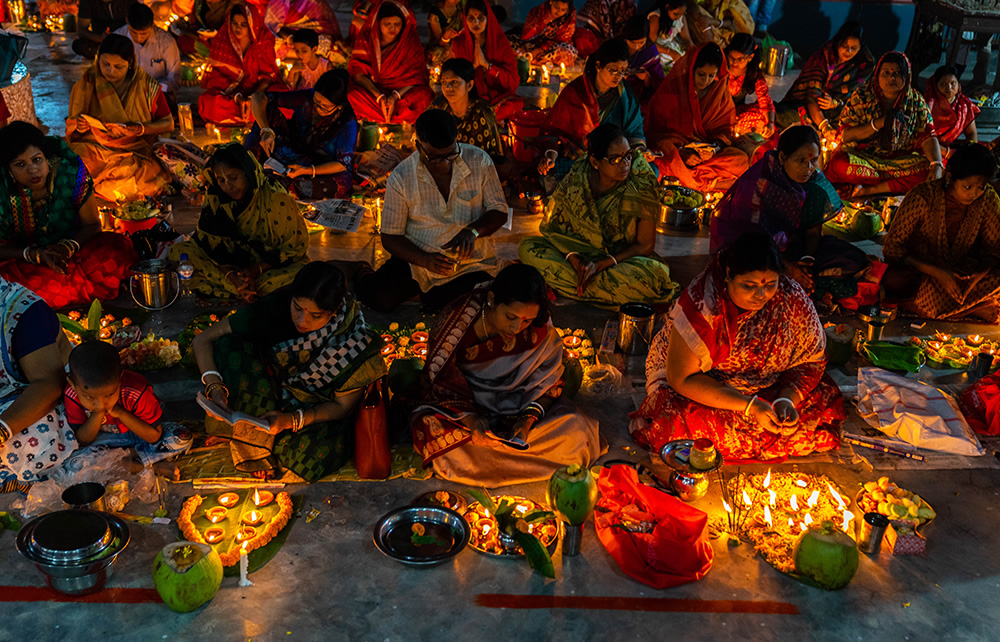- Edited

Puraścaraṇam (puraḥ - "before" and ācaraṇa - “practice”) is the mode of performing a number of different rituals to fully appease the chosen deity, in order to receive darśan, start interacting with the deity and/or to obtain a specific benefit out of the mantra (mantra siddhi).
Although the mantra obtained from the Guru is already efficacious and the performance of Puraścaraṇam is not required for a person who wants to attain liberation (for whom the performance of regular japa is sufficient), a sadhaka may wish to undertake a more focused practice to fulfill special saṅkalpa (receive a darśan, cure a disease, etc.).
To read more on Guruji's views on fulfilling one's desires in Tantra, click here.
With regards to Puraścaraṇam in order to fully please the Deity, one needs to utilise all the available means, i.e. 5 elements:
- space-japa,
- air-pūjā,
- fire-homa,
- water-tarpaṇa/marjanam,
- earth-annadānam
It should be noted that there is no guarantee that one’s saṅkalpa will be fulfilled upon the completion of puraścaraṇam because both grace and faith are a major part of the equation. A continuation of performance of puraścaraṇam beyond the initially set timeframe might be required in order to manifest the saṅkalpa.
GENERAL GUIDELINES
- A person needs to set a saṅkalpna which will include the need to be fulfilled and will set specific time frame (i.e. 60 days) during which the Puraścaraṇam will be performed.
- If after the performance of the Puraścaraṇam the desired effect is not reached, it is recommended to repeat its performance.
Mantra Japa:
Usually the total chanting of the Puraścaraṇam should be equivalent to the number of syllables in the mantra multiplied by 100,000 (1 lakh). However for most mantras Guruji recommended a total of 100,000. When the time frame has been set, it is necessary to complete a specific quantity of chanting everyday. One should decide the number of rounds depending on one’s capacity. If the number is reduced, then more days will be required to complete it and vice-versa. However, one should remember that as far as possible one should complete the number of rounds decided in the beginning.
Pūjā:
Even though pūjā explicitly is not included in the Puraścaraṇam (with an exception of Kulārṇava Tantra, see post below), in this approach it should be performed daily during the entire period of Puraścaraṇam. Interestingly, pūjā in itself already includes all of the other elements of worship (i.e. mantras/stotras, lamp/camphor, tarpaṇa/abhiśekam, naivedya as annadānam, etc.).
Homa:
After the completion of the predetermined quantity of japa, a homa (offering an oblation with fire) is performed with 1/10th of that quantity. If this is not possible, then one should perform japa in an amount of four times the quantity of fire oblations, which is additional to the count needed for Mantra Japa.
Tarpaṇa:
Tarpaṇa of the chosen deity is performed with 1/10th of the quantity of the homa offerings.
Marjanam:
Marjanam of the chosen deity is performed with 1/10th of the quantity of the tarpaṇa offerings. It is performed with approximately half a litre of water mixed with a teaspoon of ghee. A spoonful of this water is held in the palm of a hand while reciting one count of the mulamantra after which it is sprinkled on top of the head.
Annadānam:
One should offer food to people in a number equivalent 1/10th of the quantity of the marjanam.

